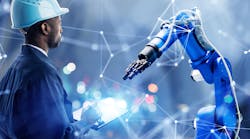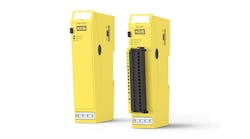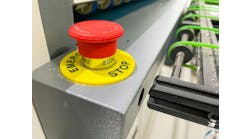Tell us about your company’s state-of-the-art safety offerings.
Brian Kundinger II, vice president, Kundinger: Kundinger is a leading manufacturer and calibrator of monitoring and control systems dedicated to protecting businesses and critical infrastructure. We use the latest in sensing technologies to provide reliable detection and alarming for hazardous gas, refrigerant leaks, level/pressure/temperature/flow variations or floods. All our products are calibrated with precision that meets or exceeds industry standards and are fully supported by our team of expert engineers and technicians.
Our team has extensive experience in distributing and integrating products from Sick and Leuze, such as machine safety/hazardous point sensors, hazardous area and access monitoring systems and building/ground monitoring solutions.
We strive to stay at the forefront of safety technology innovation, offering advanced features like remote access through mobile devices or integration with existing IT systems. With these features, our customers can confidently monitor their operations from any location at any time and quickly react to potential hazards or irregularities in safety systems utilizing a simple user interface.
Our commitment to safety doesn’t stop there either; we have established ourselves over the years as a leader in the industry, thanks to the quality of our offerings. We regularly assess emerging technologies so we can provide top-notch products, as well as a superior customer-service experience.
What have been the biggest improvements in safety over the past five years?
Brian Kundinger II, vice president, Kundinger: In the past five years, there have been a number of significant advances in workplace safety that have revolutionized the way we approach safety protocols. One of the most notable advancements has been the use of light detection and ranging (LiDAR) technologies in collaborative robotics. This technology uses lasers that generate a 3D map of an area and makes robots aware of their position and surroundings to detect obstacles or hazards. It is being used increasingly in places like warehouses and manufacturing facilities where manual labor or hazardous conditions may pose a risk to human workers.
Another major advancement has been the development of "safe motion" technology, which slows down production without requiring complete shutdowns. Through advanced sensors and computer-vision algorithms, these systems can detect potential dangers before they occur, allowing operators or robotics to adjust certain parameters, such as speed or power levels to safe conditions. This reduces the potential for serious occupational injuries while keeping production running at optimal speeds.
What’s the most innovative or efficient safety application you’ve ever seen or been involved with?
Brian Kundinger II, vice president, Kundinger: One of the most innovative and efficient safety applications Kundinger has helped to implement used laser monitoring devices, safe motion drives and motors to facilitate collaborative workspaces between humans and robots.
Lasers allowed robots to operate near humans without the need for perimeter guards or segmentation of the facility, allowing for a more efficient workflow and safer overall operation. Additionally, laser-monitoring devices allowed for a range of features such as speed control, emergency stops and safety limits, which increased operational accuracy of the collaboration between humans and robots.
The use of drives and motors provided an added layer of safety by ensuring that any robotic operation could be halted if a risk is detected.
How has safety benefitted from remote monitoring and connectivity?
Brian Kundinger II, vice president, Kundinger: Remote monitoring and connectivity have significantly benefitted safety in multiple ways. First, it has enabled a much greater level of plant safety through enhanced surveillance and human intervention. For example, with the ability to remotely monitor facilities, grounds, machines and hazardous areas from a single point, multiple facilities can be monitored at once without needing to have someone physically present on-site. This means that fewer people need to be employed as plant safety personnel, which in turn reduces costs and increases efficiency.
Furthermore, since machine shutdown/slowdown is instantaneously detected by these remote-monitoring systems, potential accidents can be spotted quickly and avoided before they become serious issues.
Can you explain how software development has changed safety component design and production?
Brian Kundinger II, vice president, Kundinger: Software development has allowed for an unprecedented level of control over the components in a safety system. In the past, it was difficult for a non-technical individual to program safety devices, as it required expertise in controls engineering. Today, however, much of the safety equipment being produced is equipped with QR codes, which are easily read by a specialized app. This enables anyone—not just those with knowledge in controls engineering—to program these devices with ease. Additionally, software platforms that are open source allow for seamless integration into building supervisory-control-and-data-acquisition (SCADA) systems with plug-and-play capabilities.
How does safety figure into any digital-twin platform being used by manufacturers?
Brian Kundinger II, vice president, Kundinger: Digital-twin platforms provide significant benefits when it comes to managing safety within an organization by offering a complete view of products, machines and production lines through their entire lifecycles. This allows manufacturers to detect unsafe conditions early on, so they can address them before they become serious issues. On top of this, when any changes are made to the product or machinery, digital-twin platforms can quickly assess their impact on safety.
Digital-twin platforms also allow for easier communication between different stakeholders involved in safety management. Most, if not all, devices Kundinger offers can communicate via Ethernet and can present information to a SCADA system or the cloud, allowing multiple teams to easily access up-to-date information regarding safety protocols and regulations whenever they need it.
When will safety components and initiatives become IT-friendly enough that engineers and safety professionals are no longer required for installation and operation?
Brian Kundinger II, vice president, Kundinger: Already today, many safety components and initiatives can be set up relatively easily through learning functions or predeveloped applications.
The increasing prevalence of digital transformation in industry has enabled faster implementation of IT-friendly components, and the technology landscape is changing rapidly to keep up with demand for efficient processes. This shift is driven by advances in automation, as well as improvements in data collection, visualization and analysis capabilities.
What future innovations will impact safety in discrete-manufacturing operations?
Brian Kundinger II, vice president, Kundinger: One innovation that is expected to have an impact on safety is machine learning. This technology has already been used successfully in various industries and can be applied to industrial settings, as well. Machine-learning algorithms can detect hazardous situations and alert operators before they become dangerous or lead to accidents. Additionally, they can monitor worker behavior and alert supervisors if any unsafe practices are occurring.
Robotic systems will continue to advance, as well, and we’ll likely see no slow in manual labor being replaced by robotics because the precision, accuracy and speed will be difficult for humans to match safely.
These advancements represent a significant opportunity for companies to benefit from improved working conditions while still producing high-quality products at an efficient rate with minimal risk associated with them.






